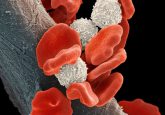Researchers identify potential new drug targets to treat AML

Scientists from the Wellcome Trust Sanger Institute (Cambridge, UK) have discovered approximately 200 genes that could be targeted to treat acute myeloid leukemia (AML).
In a paper recently published in Cell Reports, the team modified a CRISPR gene editing technique which led them to discover AML’s numerous vulnerable sites.
AML is a type of blood cancer which aggressively multiplies in the bone marrow, obstructing the production of normal blood cells,leading to bleeding and potentially lethal infections.
Currently less than 1 in 3 people infected with AML survive the cancer, highlighting the need for more effective therapeutics.
In this study researchers used the CRISPR-Cas9 gene editing technique to target specific genes in the leukemia cell genome. By inhibiting individual genes it allowed them to identify which genes were crucial to the growth and survival of AML cells.
As the human genome consists of approximately 20,000 genes the team needed to refine the CRISPR gene editing technique to only screen the leukemia genome. They discovered approximately 500 genes that cancer cells depend on to survive, 200 of which could be targeted for drug design.
Out of these 200 genes, the team then decided to focus on the KAT2A gene to validate their findings. Using genetic and drug based techniques they inhibited KAT2A and found a reduction in AML cell survival, not affecting the life cycle of normal blood cells.
This then led to studies in transgenic mice where the KAT2A gene was inhibited. Results demonstrated these transgenic mice had significantly longer survival rates than mice with KAT2A expression.
“This research has led to the identification of many potential gene targets for future AML therapy, which we are making available to other researchers to explore. Whilst KAT2A inhibition now needs to be investigated as a treatment strategy for acute myeloid leukemia, there are many more candidates to pursue by the leukemia research community” said project leader George Vassilou.
“Our hope is that this work will lead to more effective treatments against AML that will improve both the survival and the quality of life of patients” he added.
Sources: Tzelepis K, Koike-Yusa H, De Braekeleer E et al. A CRISPR dropout screen identifies genetic vulnerabilities and therapeutic targets in acute myeloid leukaemia. Cell Reports 17, 1–13 (2016); www.sanger.ac.uk/news/view/vulnerabilities-leukaemia-cells-revealed-using-genome-editing-technique




